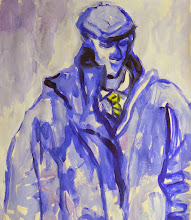What was bothering me was that my two dancers were a bit thin and spindley, and lacking the force and presence of Paintings 1 & 2. So I go back to the sketchbook and give some thought to the overall proportions and how the figures should occupy the space:

I have a feeling that what I need is the figures to fill the space better, and touch the edges. Each window, blue, red and gold, considers various degrees of cropping to determine what is the best format to say what I want about this image.
I decide that something narrower than the full square format is better and start working this up as a Neocolour sketch:

Everytime I do this it reinforces the idea in my head building up a knowledge and feeling that will express itself when the (final) time is right (I hope).
The figures are much chunkier now and more satisfying, but I need to do some more work on an area of difficulty. In the previous attempt I repeatedly came a cropper with the ballerina's head, scraping it off and starting again, and again. This time I make a series of studies solely on this element till I work out how best to tackle it before starting the painting for real. In this way I take the painting of it into myself, like a musician practising his scales before the final performance:

Now I'm ready to get started properly. But my confidence is still a bit low. What I came up against in the previous attempt was in trying to paint directly (as per first two paintings) the lack of established guidance was in fact a hindrence. I didn't instinctively draw/paint the figures correctly and, since I don't want to fall into that trap again, I draw the figures freehand this time in oil pastel before painting:

I am fortunate that my drawing capability doesn't let me down and the figures are just as I want them...more robust and having presence.
With this drawing in place I set about the painting in much the same manner as before with paint-laden brushes blocking-in the dancers (this time with the knowledge in my head) and then cutting in with the background:

This time I am pleased with the outcome, though perhaps not as excited as my previous two paintings. And rather than a scene from The Sleeping Beauty it looks more like Les Ballets Trocadero de Monte Carlo with a big muscular ballerina!
I still like it as a painting, however, and won't make any more changes.
Painting is a bit of a roller-coaster, and it doesn' work out exacly as one would want every time, but on the whole I am satisfied with the outcome of this painting project and ready to move on to my final painting in this series.















